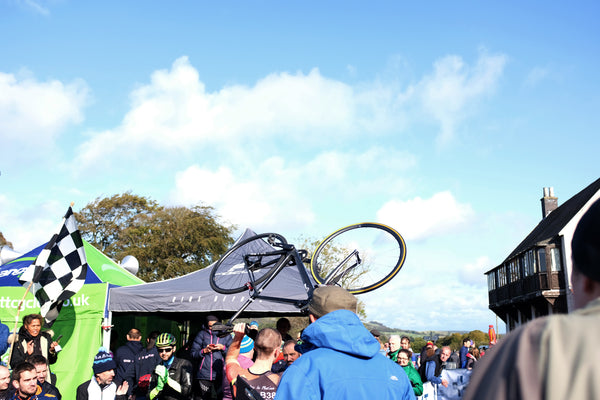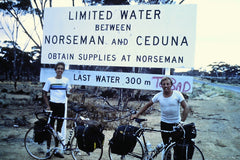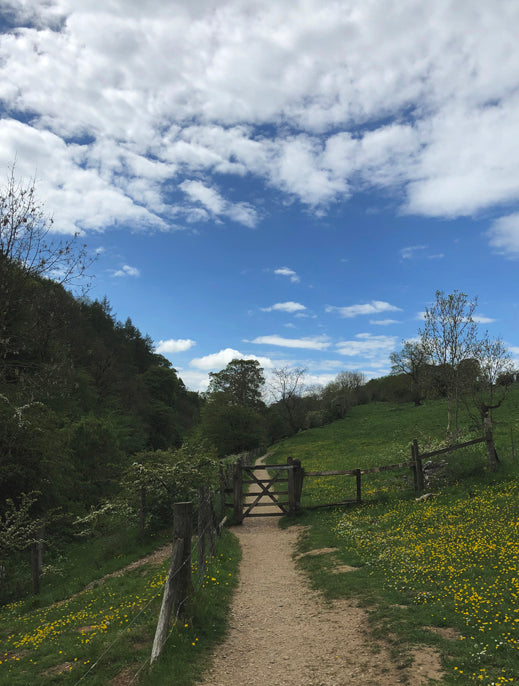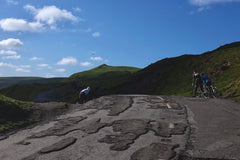Miles Munchers #1 ~ Felix Ormerod


























































It's hill climb season and one of the main attractions on the calendar is the Monsal Hill Climb at Monsal Head, Derbyshire.
First run in 1930, this has been a fixture in the diary of those who enjoy the pain-cave for an amazing 89 years!
Malcolm Elliott holds the current record that has stood since 1981 ~ 1:14.2
Will it ever be broken? Not this year!








All photos by Thom Barnett
Continue readingThere is sometimes something new to be found in something old. I have always enjoyed the camaraderie and tales that come with riding with a cycling club - we all love a good story and if it involves the bike then even better!
Whilst out riding with the famous Sheffield club Rutland CC I've heard numerous stories during cafe-stops including fights in fancy dress, drunken shenanigans and the odd 'epic' ride.
One story that kept popping up was the round the world trip of four Rutland members back in 1980, so I got in touch with one of these men, Malcolm Pearce to see if he could shed anymore light on it for me.
What transpired during this trip, along with Malcolms photos are now published below. Enjoy!
__________________________________________________________________






































I've explored these parts many times on the road bike, both the road and rough-stuff from the top of Beeley Moor. I've noticed a few footpaths and bridleways that I thought would be worth checking out on foot.
The influence of Chatsworth house on the surrounding villages of Pilsley, Edensor and Beeley can be felt in this area, for over two centuries Beeley was effectively an estate village belonging to the successive Dukes of Devonshire.
Many of the properties now have been sold-off but the village pub, The Devonshire Arms, has been brought back into the Duke's control in recent years. Formally three separate cottages, these were knocked together. King Edward VII and Charles Dickens are both said to have stayed there and this is where we started our walk.


The first part of the route leads up through the plantations, running next to Beeley Brook and Moor Farm, before opening up across the open fields of Beeley Moor. From there you can visit Hob Hurst's House, a Bronze age burial mound named after a mischievous goblin (or giant) which lives in the nearby woods.
Dropping back down into the woods across Beeley Brook you cross the road and take the bridleway for approx 1 mile, eventually encountering the remains of industry in the woods just beyond Fallinge Farm. As early as the mid-1600s a lead smelting mill has been established on the hillside, fuelled by coal dug from a seam on Beeley Moor.


Once you leave the woods you cross several fields and across numerous wall stiles, heading back towards the village. The Devonshire Arms serves Jaipur, or you can nip in The Old Smithy Cafe for homemade cakes and tea.
Start + Finish ~ Grid Reference SK265676
All words and photos by Thom Barnett
Continue reading“Lathkill is, by many degrees, the purest, the most transparent stream that I ever yet saw either at home or abroad…” ~ Charles Cotton, 1676

If you park at the Lathkill Hotel at Over Haddon as we did, you can walk down the winding lane to the Lathkill lodge, or you can ride here but you’ll need a change of shoes in your saddle bag, or cycling shoes that are ok for walking (the route is approx 8 miles).
Before you reach the lodge, you will turn right onto this beautiful limestone dale next to the River Lathkill. Down here, there is a scene of ash trees, growing beneath limestone crags, scree and pastel coloured grassland. You’ll notice the crystal clear stream and if you stop to inspect, you may even spot some darting trout.

Lead miners came here in the 18th and 19th century, some of the mine caves are still there for you to inspect. They drilled shafts and adits into the rock and built pump houses, aqueducts, waterwheels and even tramways. Due to overseas competition, the price of lead slumped and by 1870, the pistons stopped.
There are remnants of that time here, the Peak District’s industrial past, now surrounded by lush plants. The valley is full of sycamore and ash trees. Amongst them you’ll see the mossy pillars, remains of the aqueduct built to supply water to the Mandale Mine which is close by. You can cross the river in places, a nice bridge allows you to inspect Bateman’s House, the former mining managers dwelling.


I have since been told that in dry periods of summer, the river disappears completely beneath the bed of limestone to be replaced by purple orchids, cowslips, primrose-like flowers and rock rose. Although, truth be told, I’ve never witnessed it.
When you exit this twisting valley you will arrive at Monyash. Here you will find a pub ‘The Bulls Head’ and a cafe ‘The Old Smithy’, a popular cycling destination for local riders. The pub once held the miners special Barmote Court.


The return leg of the walk is along high pastures overlooking the valley that you’ve just walked through, via Cales Dale and Calling Low this is know as the Limestone Way. You can nip through Meadow Place Grange to get back to the lodge where you started your walk.
If you want to make a weekend of it, there is Haddon Hall nearby, home of the Duke of Rutland. One of the finest and unspoilt medieval manor houses in England and used as a location for countless films and tv drama including Jane Eyre and Price and Prejudice.


All words by Thom Barnett
Photos by Lulu Watson
Continue readingFor a short time I considered trying my hand at bike racing. This was before I realised how hard racing actually is! Every cyclist must be able to relate to the visions of grandeur that you have when you start getting fit. You start with the bike, you enjoy it, you ride more and more and you get fitter. Then you ask yourself the question “I wonder if I should race?“.
A good friend told me “Apart from a small number who are good enough to win races and enjoy it, most lads who race do it to prove something to themselves or to others”. It spared me the time, money and embarrassment of turning my bike rides into hard training-rides and pinning a number to my back. I don’t regret never trying. I have still been fortunate enough to ride with some good riders, some proper talent.
The idea of putting the bike in the car at weekends, driving to a race only to get my head kicked-in, all in front of one-man and his dog, does not appeal! When you fantasise about racing your bike, you’re riding the Giro or de Tour, dropping people in the mountains, in the sun. When in reality, you’re more likely to be getting blown out of the back on a dismal circuit in the rain!
Long weekend rides made more sense. Riding with friends who know the etiquette and ‘how to ride’. It made sense then and it still does now. Straight out of the house early, riding all day, side by side, good conversation, great routes exploring new roads, a cafe stop (usually a pub stop!) - halcyon days!











Having said that, I'm glad there are people with the drive, the talent, the skill and the capacity to suffer, or who want to prove something, who race bikes. Because I love watching top notch bike races.
I was lucky enough to watch a friend win the best known and most prestigious domestic race on the calendar, Lincoln Grand Prix.
There are some photos I took from that event ~ here
Words by Thom Barnett / Photos by Nick Newton
Continue reading
This year we have released the Buxton chukka boots, a repeat run of our popular Royals and our latest Derby (or Blucher) shoes - the Ashop. In the past we have done an Oxford-cap shoe named Winster and a loafer named Abney as well as the robust and utilitarian Yompin’ boots.
All of the names for our shoes are after places in the Peak District. All have been proudly made in England.


The use of high-quality leather is essential in British shoe manufacturing and all our shoes (apart from our Hibell cyclo-touring shoe) have been manufactured in the mecca of high quality British footwear, Northampton. All of the best known British shoes are made there, although unfortunately now, many ‘supposed’ British brands now outsource their manufacturing to Portugal and India.
One of the factors that makes British footwear stand out is the tanning process which preserves the leather and due to the water sources that are available in Northampton many shoe-makers opened up close to these tanneries.
The other detail that makes the construction of our shoes so solid is the Goodyear-welt, which is the dual-stitch reinforcing sole technique that provides resilience in British weather as well as ensuring the shoe will not come apart if and when they need servicing by your local cobbler.
Another advantage of the Goodyear-welt is that when the sole is replaced, the form of the shoes stays the same so you only have to break your shoes in once.


A pair of Goodyear welted quality British shoes work well with a variety of different looks and styles and are a great investment that will last many years.
To view all of our shoes and boots click ~ here
All words by Thom Barnett
Photography by India Hobson
Continue reading